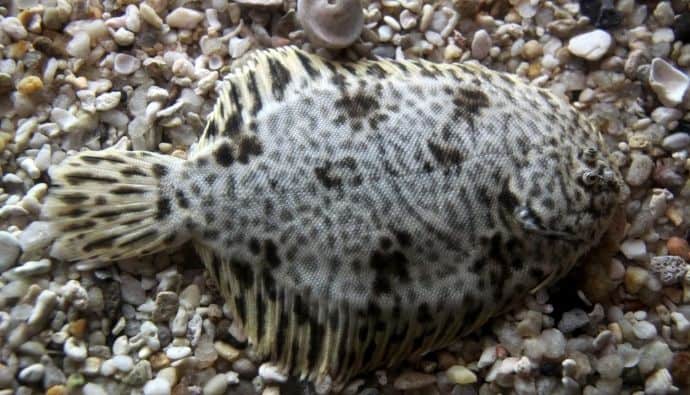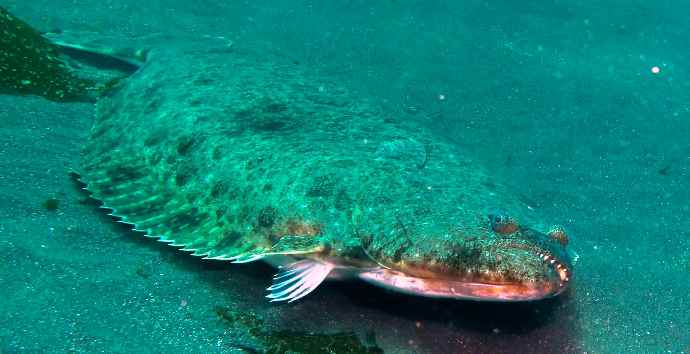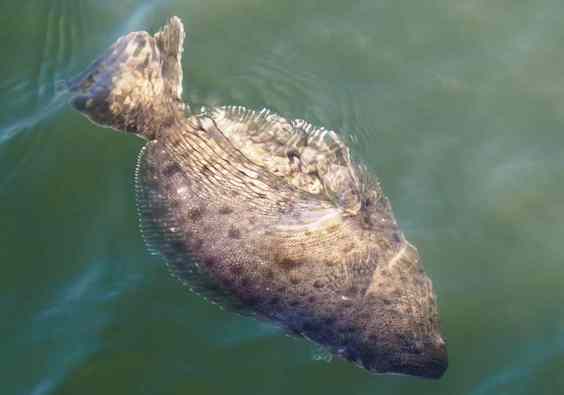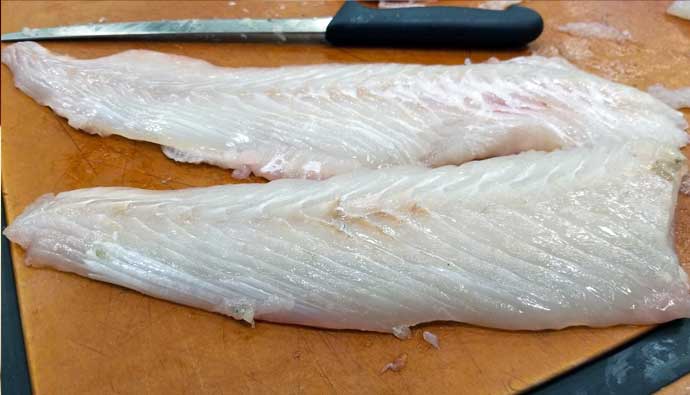Halibut and flounder can be differentiated by their body shape, size, and tail. Halibuts are generally larger than flounders, with adult halibuts weighing up to 400 pounds and adult flounders weighing up to 30 pounds. Flounders possess a round body shape, while halibuts have a more diamond-like form. This distinct shape of the halibut is a result of its elongated body and pointed dorsal and anal fins, whereas flounders feature shorter, round bodies with uniform fins. Additionally, most halibuts have a forked tail with sharp ends, while flounders typically exhibit rounded or flat tails. Another difference lies in the placement of their eyes: halibut eyes are on the right side of their head, while flounder eyes can be found on either the left or right side. When it comes to taste, halibut offers a firm texture, while flounders provide a richer, fattier flavor.
Despite their differences, halibut and flounder do share some similarities. Intriguingly, all halibuts are flounders, but not every flounder is a halibut. So, how can you tell these species apart? Keep in mind the key differences outlined above when distinguishing between halibut and flounder.
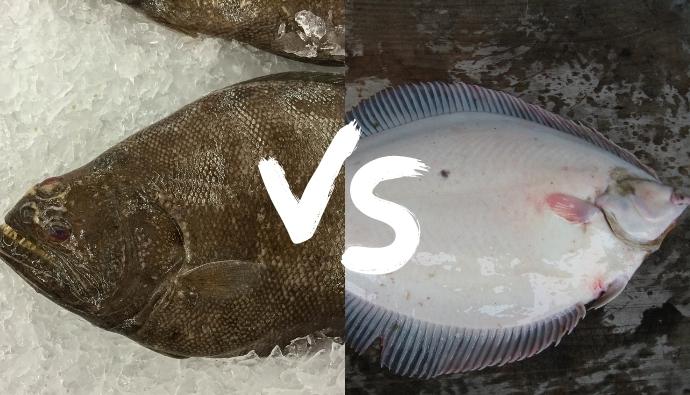
Halibut vs Flounder: What’s The Difference?
Halibut and flounder are two of the most popular fish among fish lovers worldwide. In this section, we will break down the difference between them, enabling you to recognize each species with ease.
Identification: What Makes Halibut and Flounder Different?
The main difference between a halibut and a flounder can be broken down into three parts which are body shape, body size, and tail shape.
Before we go into the details about the key differences, it is important to note that there are only two main species of halibut which are Atlantic and Pacific halibut. California halibut is a different kind of fish, so we will not include it in this comparison.
The body size is the first and easiest giveaway when trying to differentiate between a halibut and a flounder. This is because halibut happens to be a large fish, while flounder, on the other hand, is much smaller in comparison.
As a matter of fact, both Pacific and Atlantic halibut usually grow to be around 8 feet long, weighing about 400 pounds. In comparison, flounders weigh between 5 to 30 pounds at full maturation. As such, halibut provide a lot more meat for food, which explains why they are referred to as doormats or barn doors.
The problem with relying on size to tell these fish species apart is that they are usually similar in size to juveniles. This brings us to another means of identification which is body shape.
Flounder can be described as having a round body shape, while halibut have a diamond shape. Halibut get this shape from their long body and pointed dorsal and anal fins.
Due to being smaller, flounders have shorter bodies, with their uniform fins giving them a round shape. Flounders usually have thick scales, while halibuts have smaller scales.
So when next you go halibut fishing, look out for pointed fins or round fins. The difference lies there.
Another way to tell flounder and halibut apart is through the shape of their tail. Most halibut have a forked tail with pointed ends, while flounders have rounded or flat tails.
The positioning of the eyes can also be used to identify if a flatfish is a flounder or halibut. One interesting thing about the whole family of flatfish is that their two eyes are located on one side of their bodies.
They are usually born with eyes on either side, but as they lay more on one side of their body, their eyes migrate slowly until they end up on the opposite side.
Halibut are known to always have their eyes on the right side of their head. For flounders, their eyes can either be on the left side or right.
Are Flounder and Halibut the Same Species?
Flounders and halibut are different species and do not belong to the same family, even though they belong to the same order Pleuronectiformes.
Halibut belong to the Pleuronectidae family, while most flounders belong to the Paralichthyidae family. With both species being members of the flatfish family, you can be sure that they have a lot in common.
They are both demersal fish that live at the bottom of seas and lakes, waiting for food. In addition, flounder and halibut are predatory fish that feed on sea animals, crustaceans, and other fish.
Flounder and halibut also have the same coloring, usually brown or mottled green with a white underside. Their skin color allows them to camouflage by adapting to the color of sand. Sadly, the Atlantic stocks of both flatfish are being critically overfished.
Where Do Flounder and Halibut Live?
The location to find flounder or halibut depends on the type that you are fishing for. Halibut usually live farther north of every species of flounder. If you are looking for Atlantic halibut, the best place to find them is on waters close to Cape Cod.
The Atlantic halibut population is quite low, making them an endangered species. They can also be found in Greenland and northern Europe. Pacific halibut can be found on the Western coast of Alaska, all the way down to areas in Northwestern US.
Flounder are more widespread than halibut, so you can be sure to find them in areas from the Pacific Coast to Mexico. There are 3 types of flatfish that are known as flounders – yellowtail flounder, winter flounder, and summer flounder. Summer flounder can be found in Massachusetts, Cape, Cape Cod, and North Carolina.
Other flounder species, like Southern flounder and Gulf flounder, can be found in the Atlantic Ocean and the Gulf of Mexico. Winter flounder can be found in North Carolina and the Gulf of St. Lawrence, Canada.
You’ll find a lot of southern flounder and summer flounder almost everywhere starting from the Gulf of Maine to the Gulf of Mexico.
Do Flounder and Halibut Taste the Same?
A piece on flounder vs halibut is not complete without discussing their taste. The straightforward answer to the question is no. Flounder and halibut do not taste the same. They have similar tastes but are different in makeup. While halibut has a firm texture and more meat due to its size, flounder is more delicate and flakier.
Halibut is also less of a fatty fish than flounder. As a matter of fact, halibut is less fatty than most fish that are edible. The firm texture of halibut and its fat content makes it perfect for grilling.
Flounders are slightly fattier than halibut with thinner meat fillets. As such, they taste best when baked or pan-fried. Flounder and halibut have incredible health benefits, such as lower blood pressure and improved cell and brain health.
Frequently Asked Questions
In this section, we will answer some frequently asked questions about flounder vs halibut.
The flounder is one of the healthiest fish species in the world. Along with halibut, they are classified as superfoods due to the number of nutrients that they contain. Flounder is a good protein source containing amino acids and omega-3 fats. It is also rich in vitamins and minerals, including magnesium, phosphorous, and vitamin B.
No, flounder is not related to cod. Flounders are Pleuronectiformes, while cod are Gadiformes. As such, they do not even belong to the same order. However, both flounder and cod are bony ray-finned fish.
Yes, a flounder is a quality fish that is not only delicious fish but also very healthy. It can also be used for a wide range of recipes.
Yes, halibut can be referred to as a big flounder. This is because flounder is the general name for most species in the flatfish family. Halibut are commonly referred to as right-eyed flounders. There are three major species of halibut which are Atlantic halibut, Pacific halibut, and Greenland halibut.
Conclusion
Undoubtedly, halibut and flounder are two fish that are loved universally by seafood lovers worldwide. The aim of this article was to provide a detailed explanation of the differences between the species.
Due to its lower fat content and bigger meat, halibut is the best choice. For people on the East Coast, there is better access to flounder, so it is better to choose that.


 Facebook
Facebook YouTube
YouTube